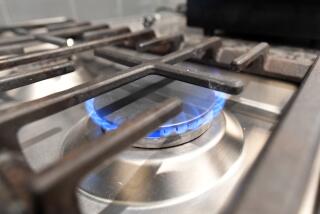Briquettes May Pose a Health Threat When Used in Enclosed Areas
- Share via
Burning charcoal briquettes in enclosed or improperly vented areas could lead to potentially fatal carbon monoxide poisoning, according to a warning issued recently by the L.A. County Health Department.
The problem becomes more of a threat during winter when barbecue grills are used for both warmth and cooking in recreational settings.
A federal study covering the years 1979 through 1986 found that there were 83 deaths nationwide that could be attributed to briquette fumes concentrated or trapped in enclosed areas. Most of the victims burned charcoal inside a camper or tent. Fatalities have also occurred in residences.
There are no warning signs before the onset of illness because carbon monoxide is a tasteless, odorless and invisible gas. The early symptoms include headache, confusion, dizziness, nausea and eventual loss of consciousness.
Partially venting the fumes by opening a window or using a fan is ineffective because of the high concentrations of carbon monoxide given off by the coals. As a result, consumers are warned not to burn charcoal briquettes for heat or cooking in homes, tents, motor vehicles or similarly enclosed areas.
Illness and Impoverishment--Health problems posed by cooking fuel fumes are even more acute in many underdeveloped countries, according to an article in World Development Forum, a newsletter published by The Hunger Project, a San Francisco-based group.
U.N. statistics estimate that as many as 400 million people are subjected to a variety of illnesses because of the toxins and smoke produced in enclosed, rudimentary cooking areas.
“Most people in developing nations still live as their early ancestors did, burning firewood, dried cattle dung and (tree) stubs in poorly vented open hearths,” the newsletter states.
Inhalation of such fumes is linked to chronic lung diseases and a number of cancers. In Kenya, for instance, respiratory tract cancers are much more common in the climatically cooler areas of the country where cooking is done indoors than in the temperate regions where food is heated outside of family dwellings, the report found.
Furthermore, women are disproportionately exposed to such fumes, and the corresponding illnesses, because they are traditionally called upon to prepare meals.
Spoilage as Innovation--The California Milk Advisory Board is in the midst of introducing several new dairy products in hopes of increasing milk consumption. One of the items being evaluated for future test marketing is butter oil.
However, it’s unlikely that California’s dairy industry will follow the lead of its European counterparts when it comes to actually producing a pourable butter.
The European Economic Community recently sold a dairy product that was labeled as butter oil to the Soviet Union. But the substance in question was actually butter that had begun to deteriorate or liquefy due to improper conditions, according to California Farmer magazine.
The shipment was originally part of the EEC’s surplus production, which began to deteriorate while in storage. After having been damaged, the commodity was reclassified as an inferior food product and renamed butter oil, the article stated.
The reclassification allowed the EEC to sell the butter to the Soviets for $450 a ton, substantially less than what is the established price of $1,200 a ton under existing tariffs.
Although able to unload food of otherwise suspect quality, the sale was, by no means, a windfall for the Europeans. At $450 a ton, the EEC received only 14% of what it actually paid dairies to produce the so-called oil, the magazine reported.
Salt in Harm’s Way--Concerns about the relationship between sodium intake and the increased incidence of high blood pressure have tended to obscure salt’s centuries-old role as a preservative. Now researchers are attempting to pinpoint exactly how salt destroys bacteria in cured meats such as ham, bacon and frankfurters.
The work is being conducted at the U.S. Department of Agriculture’s Eastern Research Center in Philadelphia. Defining the exact process is important to determine whether another compound could be substituted for salt in processed meats without any corresponding decline in food safety. Known alternatives have unacceptable side effects such as off flavors or high costs, according to a USDA report of the study.
Although the work continues, the researchers have already determined that salt inhibits contamination by preventing bacteria from latching onto the meat’s surface.
The harmful organisms are preempted from reaching the meat by tiny electrical charges given off by the two chemical constituents of salt: sodium and chloride. The electrical activity was discovered while meat soaked in a brine solution, a mixture of salt and water.
The electrical charges served to prevent organisms from following their natural path toward the meat, which provides the moisture and nutrients needed for the bacteria to multiply.
Despite the program’s progress, the USDA project is still far from developing a preservative that might safely act as a salt substitute.
More to Read
Sign up for Essential California
The most important California stories and recommendations in your inbox every morning.
You may occasionally receive promotional content from the Los Angeles Times.













